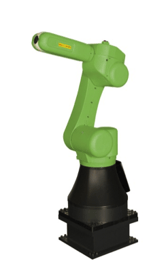Industrial robots are generally used at some distance from people, to ensure human safety. Along with advancement in sensors and control technology, the latest version of the International Standard covering robots (ISO 10218) permits people to collaborate with robots. In Japan, as well, a partial revision of the Occupational Safety and Health Regulations of 2013 makes the regulation of safety fences and other protections less strict, which makes collaborative work between workers and robots possible.
On the other hand, these changes mean that safety evaluations have become very important for robots if they are to work with people.
FANUC’s collaborative robot, CR - 35iA, is the world’s first collaborative type robot. It has a 35 kg payload. Since it does not require a safety fence, it has become possible to increase work efficiency as workers and robots work together in the same area to perform various tasks, such as carrying heavy objects and assembling parts.
TÜV Rheinland has evaluated this product for compliance with the European Machinery Directive and the EMC Directive. It was approved for safety and received the TUV Bauart Mark.
The FANUC website: http://www.fanuc.co.jp/ja/product/new_product/2015/201503_kyoudourobot.html(Japanese).
It is anticipated that the demand for collaborating robots will increase in a wide range of fields and applications in the future. Safety assessment will lead to ensuring safety in workplaces where collaborative robots are used, eventually improving work efficiency.




